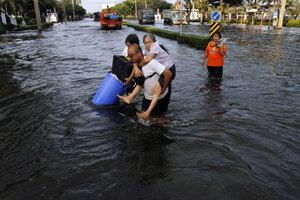Thailand floods: Some residents defy warnings and stay to help evacuees
Despite the various evacuation warnings that Thailand floods are serious, Bangkok citizens are staying in the inundated areas and doing what they can to help those who need it.

A man carries his mother during an evacuation as floods advance into Bangkok Oct. 27. Thailand's prime minister said Bangkok was fighting the forces of nature on Thursday as floodwater threatened to break through dikes protecting the capital.
Sukree Sukplang/Reuters
Bangkok, Thailand
In a corner of the upstairs departure terminal at Bangkok’s now-closed Don Muang airport, Chutimas Suksai and six friends are taping empty water bottles together to create an improvised raft.
Ms. Chutimas, a student from Thammasat University, on the other side of the city, has spent most of the past two weeks volunteering her time to help some of the hundreds of thousands of Thais affected by three months of rain and flooding, which has killed more than 360 people, with an estimated 1 million of Bangkok's estimated 12 million residents already evacuated.
When Thailand Prime Minister Yingluck Shinawatra announced that the capital should brace for four to six weeks of flooding, citizens who stayed in Bangkok, such as Chutimas and her friends, started looking for ways to help people ride out what could be a long-lasting deluge.
“It seems some of Bangkok will be flooded for a long time, so we will give these rafts to people in Rangsit [a flooded suburb to the north of the airport], so they can float food and water to their homes,” she says.
Despite the various evacuation warnings coming from the national government and the Bangkok city administration, many people – especially those with upstairs rooms and access to boats or big-wheel trucks – are staying in the inundated areas and doing what they can to help those who need assistance.
“My house is OK, so I come here [to Don Muang] to help out those who have suffered,” explains Ramluek Nitiwatanvicharan, who hails from the Chatuchak area near Bangkok’s famous flea-market, which will not open this weekend for the first time in a year.
'Slow-moving tsunami'
Outside, the usually traffic-thronged highway and numerous cars are under 5 feet of water, and thousands of other vehicles are parked on the ascending toll way above the floodwaters.
The Bangkok flooding has been described as a “slow-moving tsunami,” evoking comparison to the 2004 disaster that hit southern Thai beach resorts.
Northern Bangkok suburbs such as Rangsit and Pathum Thani flooded almost two weeks ago, while an hour outside the capital, Ayutthaya, the famous site of spectacular old temple ruins, has been swamped for more than three weeks. Satellite images show the city to be an island surrounded by a mass of water to the north - home to rice-growing farmers and industrial plants hosting the likes of Honda and Toyota - with nowhere for the water to flow to the Gulf of Thailand but through the vast capital.
Information break down
Still, information about what might happen to the city has been rehashed and changed many times, with various officials and departments often contradicting each other and flip-flopping in their responses more than the horde of backpackers on the Khaosan Road.
Chutimas, the university student, says civilians are not helping the information problem. “People are spreading rumor all the time, by phone, and social network,” she says. “I was checking my iPhone at Ari [a station on Bangkok's Skytrain] yesterday, and people were tweeting that it was flooded, that sewers had burst. But I was standing there, it was dry.”
The recently-extended train line, which runs 20 feet above the Bangkok street level, and covers much of the inner city is likely to be a vital transport lifeline should floods spread.
While millions of Bangkokians await the slow-moving floodwaters, the inner city remains precariously dry. As the Monitor reported yesterday, overflow from the Chao Praya river ran into streets along the temple-dotted riverside. Thongthong Chandrangsu, a spokesman for the government's Flood Relief Operations Center said on Thursday that “the level of the water spreading through many parts of Bangkok was rising because there was more water flowing in than being drained out.”
A network of canals runs through the city, and the combination of high tide and a mass of floodwaters coming from the north could see the canals overflow, putting the business and shopping downtown district of Bangkok at risk.
